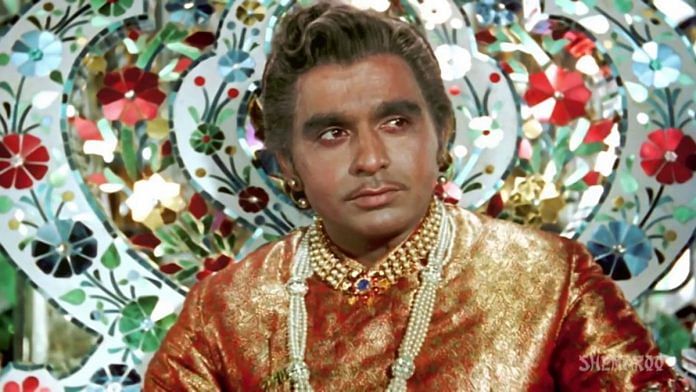
Thank you dear subscribers, we are overwhelmed with your response.
Your Turn is a unique section from ThePrint featuring points of view from its subscribers. If you are a subscriber, have a point of view, please send it to us. If not, do subscribe here: https://theprint.in/subscribe/
I have had the rare experience of understanding Dilip Saheb as a producer and as a human. And this was through the documentation and communications that Dilip Saheb had with Sterling Investment Corp Pvt Ltd during 1950s and 1960s and during a series of my personal interactions with him and Saira ji at time of release of Mughal-e-Azam ( colour ) in 2004 and thereafter.
By mid 50s, Dilip Saheb was an established star and he was about to take the next leap in his career as a producer. He wanted to make a film with outdoor shoot and that too in colour, thus making it an expensive affair. With a new producer, most financers found it a risky proposition and offered unfair terms.
By this time, Mughal-e-Azam’s shoot was still under-production and given the level of monies being sunk, trade pundits had given all hopes on any kind of recovery for the producer and financier Seth Shapoorji Pallonji Mistry (the owner of Sterling Investment).
Dilip saheb and Shapoorji had a very high level of respect for each other. Given this background Shapoorji’s experience with his first venture with films, Dilip saheb was reluctant in asking Shapoorji for any kind of finance.
So, when on the sets of Mughal-e-Azam, Dilip Kumar was looking perplexed, Shapoorji asked in a very personal tone, “Tum theek toh hai na.” Dilip saheb neither could tell the truth nor could lie to Shapoorji. With great courage, he told Shapoorji, “Main apni pehli film banana chahta hoon aur financier nahin mil raha hai.” Given their relationship, Shapoorji could easily gauge the dilemma as well the self-respect of the man. Shapoorji replied, “Kal se paise ka fikar bandh. Tum film banaao.” For four years, the entire financing was done by Sterling without any documentation on interest or on security.
By the end 1960, Dilip Kumar’s first film, Gunga Jumna was ready for release. With Dilip Kumar now being a super star and dacoit-themed films in huge demand, Gunga Jumna was a red hot product. Now, came the time for signing the commercial contract. Dilip saheb could have offered Shapoorji to return his entire investment with interest, which would have been an accepted trade practice and legally valid too. But Dilip Kumar was not any individual, he was an institution in the making. He knew, Shapoorji had not just financed him, Shapoorji had believed in him. “Trust” and “Relationship” were two pillars that defined Dilip Kumar. He offered to return the full principal plus 50% of perpetual profits to Shapoorji. No producer would offer such a humongous deal for a red hot film. Gunga Jumna costed Rs 20 lacs and the first overflow (nett profit) after six months was Rs 2 cr. The overflow continued year-on-year.
Cut to 2004, Mughal-e-Azam was about to release in its colour avatar. But for Dilip saheb, Mughal-e-Azam was always a bad memory owing to personal differences with K Asif. So much so that he had not even attended the premier in 1960. With that in hindsight, he refused to give any interviews to media on Mughal-e-Azam . As a producer, I was in a big dilemma. I had been regularly calling up Saira ji with no success. And once at 11 pm, Saira ji called me and told me, “Sahab wants to meet you tomorrow.”
Next day, during a three hours conversation, he explained the finer nuances of his relationship with Shapoorji and his philosophies in life. And during the climax, he told that Shapoorji would often say “Dilip toh mhaaro deekro chhe (Dilip is like my son). Therefore, will not be able to forgive myself if I cannot do this for Shapoorji”
Next day onwards, he opened his doors for media personnel. He gave more than 100 interviews and created a supersonic media blast. Such was his magic at the age of 81 that against Veera Zaara (powered by the deadliest combo of Yash Chopra and Shahrukh Khan), Mughal-e-Azam (color) had a 25 week run in cinemahalls.
We continued to meet and I also had the honour to attend Dilip Saheb’s birthday celebration in 2011.
Cut to 2016-2018, due to Dilip Sahab’s health, Sairaji & Dilip Sahab could not make it for any of the live performances of Mughal-e-Azam : The Musical, despite my several invitations. So, I requested Saira ji to come alone. She replied, “Deepesh ji, I will not be able to watch Mughal-e-Azam without sahib. During the entire performance I will only remember him.” That was my last conversation about Dilip saheb with Saira ji.
Post the pandemic, when the performances of the musical begin, it will not just be Saira ji but every member of the audience that will remember Dilip Saheb….!
Mar jaate hain aashiq, zinda reh jaati hai yaad…!!
Long Live Dilip Kumar.
Deepesh Salgia has produced the film Mughal-e-Azam (Colour) and Mughal-e-Azam : The Musical for Shapoorji Pallonji
Also read: Dilip Kumar was the First Khan of Bollywood, the Prince Salim of our hearts: Shobhaa De
These pieces are being published as they have been received – they have not been edited/fact-checked by ThePrint.


COMMENTS